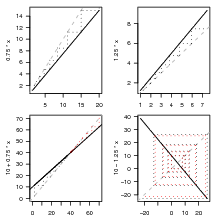Univariate (one-dimensional), discrete-time, deterministic model: N(t + 1) = f(N(t)). (Typically, state variable is continuous.) (Units of time, stock? When does discrete time make sense?)
Geometric growth (decay)
Simplest possible model. f(N) = RN (sometimes stated as f(N) = (1 + r)N). Solve recursion analytically. Now we know everything about the dynamics. Suppose N(0) > 0, R > 0 (note: the R language indexes vectors starting from 1). (What happens if N(0) < 0 ? model of debt?)
What happens if R < 0?
(Even this ridiculously simple rule — or generalizations of it — is the basis of serious modeling in conservation biology.)
The limiting set of points as t →∞ is called an attractor. If R < 1, N → 0 but N = 0 only in the limit, unless it starts there. A value of N such that f(N*) = N* is called an equilibrium (or a fixed point).
Stability: what happens for perturbations in the neighborhood of the fixed point? Consider displacing the population away from N* by δ, where δ ≪ 1; what happens?
 |
Therefore the deviation δ → δf′(N*). If |g|≡|f′(N*)| < 1 then the deviation from the equilibrium decreases geometrically with time: stable fixed point. Behavior for g < (-1), -1 < g < 0, 0 < g < 1, g > 1 …
N = 0 is always an equilibrium, stable iff |R| < 1.
Affine models
Now suppose (as in the example in the book) we are adding or subtracting a fixed amount per time step: N(t + 1) = a + bN(t). As before we can work out the recursion.
Summing the series for t steps gives a(1 -bt)∕(1 -b) + btN; the limit is a∕(1 -b) + limt→∞btN(0). If |b| > 1 this is a bit boring. If |b| < 1 we get a stable equilibrium at a∕(1 -b). (For b < 0 (“bucket model”): a is the supply rate, 1∕(1 - b) is the average residence time.)
Useful component for larger models. (Autoregressive model in time series analysis; sometimes used as the bottom level in food chain modeling.)
In general, things are not so simple. The general approach is (1) solve for equilibria (directly); (2) evaluate stability of equilibria; (3) possibly evaluate for small N (near system boundaries); (4) if possible solve for time-dependent solution.
Graphical approaches: cobwebbing

Multiple lags
What if N(t + 1) depends on previous time steps N(t - 1) etc. as well as N(t)? Homogeneous linear equations: ∑ i=0maiN(t - i) = 0. Plug in N(t) = Cλt. Solve characteristic equation …get a linear combination of geometric growth/decay, ∑ Ciλin: largest eigenvalue dominates long-term behavior.